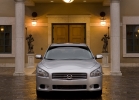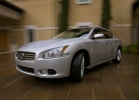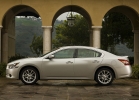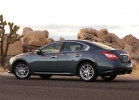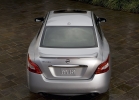Nissan Maxima test drive since 2009 sedan
The maximum economic effect
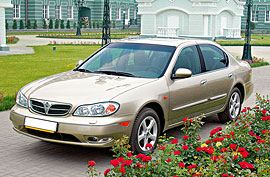 The largest passenger Nissan definitely cannot boast of the main values \u200b\u200bof the business class with the highest comfort, thoroughbred and prestige of the brand. But if you think that reliability and durability are more important for a used car, Maxim is becoming one of the best offers in the classroom.
The largest passenger Nissan definitely cannot boast of the main values \u200b\u200bof the business class with the highest comfort, thoroughbred and prestige of the brand. But if you think that reliability and durability are more important for a used car, Maxim is becoming one of the best offers in the classroom. In Europe, none of the Japanese business class models have been awarded a warm reception. Mitsubishisi-Sigma and Mazda-Cedos-9 left the market in the mid-90s, Toyota-Kamri two years ago. The current Maxim lasted the longest. But she was rather just present than sold. The fact is that in close Europe, a large passenger car does not have the right to be democratic. It must be eminent, prestigious, high -tech and expensive. Alas, Japanese business class models could not offer and therefore were doomed to the role of outsiders.
In immense Russia, as in America, a business class car has the right to be just large. Let him not be compared with a Mercedes, BMW or Jaguar, but if it costs almost half the cheaper of eminent European classmates, it will be necessary to sell. And if the machine will also be a trouble -free, market success is guaranteed to it. It was thanks to the favorable price and phenomenal reliability that the previous maxim has won the recognition of Russian buyers. And since the price and technical filling of the current model that appeared in 2000 remained practically unchanged, she also provided a generous loan of purchasing trust.
And the creditors were not mistaken. Four years later, they received a good percentage in the form of lack of problems with the machine, low operating costs and low cost of cost during resale. True, for the buyer, the last circumstance is not at all in hand. But the one who chooses the used Maxim will still not fail.
Salt harms only chrome
Most Maxim put up for sale all their kilometers in Russia. But also Aborigines cars deliver surprisingly little trouble, if you do not take into account openly tortured specimens. For example, the body must be inspected only for traces and quality of body repair. Moscow salt has so far reached the elements of the chrome decor of the grille of the radiator and door handles. However, the brilliant tinsel is not a body.
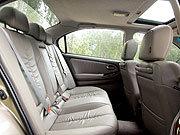
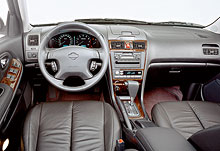
The Maxima Salon is very spacious behind. Handrails on the backs of chairs claim to perform representative functions
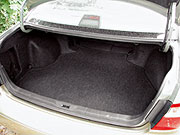
To transport long -breeders, the back of the sofa folds
According to the fittings and electrical equipment of the body, the situation is almost idyllic. The loops of the doors (especially the driver’s) begin to sag only to 150,000 km and only on the accelerated machines of firms. It happens that the front seats are refused and the air conditioner's tubes corrode. But such cases are not universal. Only the airplanes of the air conditioner are claimed for statistics (it starts to buzz over time) and the engine cooling radiator, which can flow already by 50,000 km. The bearing of the coupling is out of order from road mud. This is an old sore that Maxim inherited from the predecessor (by the way, instead of the couplings supplied in the spare parts, you can find the bearing suitable in size).
But the radiator is something new. But even if you have to spend the replacement of the heating element of the seat, the couplings of the air conditioner and the radiator, these are real trifles compared to the electric and body problems of modern European business class sedans.
How much does a replacement cost, $
Door loop 51+140
Seat heating element 344+170
Front air conditioner pipe 223+60
The clutt of the air conditioner is assembled 1022+110
Engine cooling radiator 652+50
Motors are only V6
No matter how democratic maxim, she never had modest 4-cylinder engines. According to the laws of business class, you can only get a car with smooth and prestigious V6. The gasoline engines proposed for Europe and Russia are identical in design, and differ only in working volume and power. The basic 2-liter produces 140 forces, and a 3-liter 193 horses. Both engines are combined with both manual and automatic boxes. But if you are not satisfied with just moving from point A to point B, the 2-liter machine should be with mechanics. Automatic transmission makes it too inert. Well, a 3-liter unit in the recommendations, of course, does not need. He is able to satisfy very serious ambitions with any box.
Both engines are reliable, durable and not burdensome in maintenance. For example, the camshafts in them are given by a chain, and the valve gaps, although adjusted by the washers, in real operation up to 300,000,000,000 km (cars with such runes have already appeared) usually do not go away. According to statistics, up to 200,000 km, one or two ignition coils and the appearance of the rear oil seal of the crankshaft can be expected. Otherwise, only planned then replacement of candles.
 Engines in operation
Engines in operation Oil, for both gasoline V6, it is prescribed to be carried out after 15,000 km, although some Nissan services, out of an old habit, impose an interval of 10,000 km. The spark plugs (for Russia, the Japanese recommend only platinum) on our gasoline are 30,00060,000 km. But this is a turnover. Possible failures of one or two ignition coils (in total 6 pcs.) And the same amount of lambda-zones of the exhaust system (only 4 pcs) will not ruin you either. In addition, the air flow meter and the throttle block can be frozen from dirt (the engine begins to work unstable). However, in most cases, changing them does not have to have enough flushing.
The first serious expenses should be expected to about 200,000 km. By this time, the rear oil seal begins to leak, and the timing chains (3 pcs) are stretched and taken to make noise during cold start. The oil seal is inexpensive, but the work on its replacement is laborious. But the chains with tensioners bite on their own, and the removal of the engine and installations of the engine when replacing require. However, if you divide the numbers of significant expenses into kilometers, it will turn out inexpensively.
How much does a replacement cost, $
Spark plugs 156+35
Ignition coil 153+10
Air flow meter 210+25
Crankshaft oil seal 78+550
Turners and tensioners 598+900
Choosing a transmission matter of taste
Both manual and automatic boxes do not cause complaints. The oil in them is flooded for the entire service life, but if you change it in 60 thousand, it will not be worse. The clutch in the mechanic serves on average 150,000180,000 km, and the machinery’s resource, provided that the mechanics can not be determined correctly with it. In any case, 300,000 km for him is not the limit.
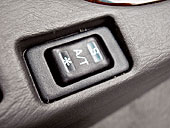
The machine gun on Maxim is tri -mode. In the middle position of the switch, an economical mode is involved. When pressing S, the sports is turned on, and the symbol of the snowflake is winter mode
By the way, in the transmission of machines with a 3-liter engine, a differential is installed, gently blocked by the WISKOFTA. In winter, in the presence of excess power, this is very useful. Moreover, WISKOFT needs any service.
How much does a replacement cost, $
Clutch (set) 373+280
Do not wait
Complex multi-link pendants on Russian roads have become Achilles fifth majority of modern business class cars. But not Maxima. Her suspension is simple, like three kopecks, and phenomenally hardy. It requires large one -time investments only by 150,000 km. Yes, there are expensive details in the suspension (if you buy the original). These are front levers assembly with silent blocks and ball supports, front shock absorber racks and thrust of the headlight corrector. The latter are especially surprised. The size of a little finger, they cost $ 156 apiece. However, the wear of the corrector’s rods is manifested only by a knock on irregularities. If you are ready to put up with him, you can ride an arbitrarily long time. The remaining expensive details serve about 150,000 km. On German classmates, the suspension for this period will have to be sorted out two or three times ...
The remaining details of the chassis are also very hardy. Figures of 100,000 km for steering rods and 200,000 km for hub bearings are more than worthy. And the steering rack! The fact that it does not flow and does not knock on cars with 200 thousand mileages is more like a fairy tale. In general, the situation is as follows: if Maxim moves in your hands a 150-thousandth line, you will spend a large time on the repair of the chassis once. You will have time to sell the car before, do not spend money even once.
 Buy?
Buy? As we have already said, by the standards of the Nissan-Maxim business class, the gray mouse. It does not exude the aroma of respectability inherent in European models, it does not shine with the special sophistication of sled manners. Her name is not pronounced with aspiration, they do not turn after. At the same time, the 2-liter cars of 20002001 are in good condition cost $ 18,00021,000, and 3-liter specimens of the same age $ 20,00024,000. That is, for three years Maxim has only dryed by 3035% of its initial price. At first glance, such a purchase is disadvantageous. After all, having paid $ 30005000, you can buy 4-year-old Mercedes E-Class, five BMW or Audi-A6, which were almost twice as much as Maxima.
But for a used car, the purchase price is only the visible part of the iceberg. The reliability and durability is no less important, that is, the cost of operation of the machine. For several years, that there is a three-year section is not age, we substantially met almost all the popular business class cars. So, in reliability and endurance with Maxim, only Toyota-Kamri can compare. German classmates with age become much more problematic and expensive in content.
Therefore, if you like Maxim, buy. She begins to demand the first serious investments only to 150,000 km. That is, having bought a car from a private owner with a real mileage of 70,00090,000 km, you can pass without worries for another 23 years, shifting large expenses to the shoulders of the next buyer.
New, with a guarantee, for the same money
Not a single new business class model at the price of a 34-year-old Maxima does not buy. You can only count on Korean and Japanese middle class sedans. The most democratic Kia-Magentis and Hyunde-Magnate are (in fact it is the same machine) of the Russian assembly. In the basic trim levels, they beat 2-liter 4-year-old Maxim, and in expensive versions, with V6 engines, a younger 3-liter.
The Japanese will cost more. The Nissan-Primer and Mazda-6 even with a modest 1.8-liter engines, in moderate trim levels are like a 3-liter maxim. However, an additional payment of $ 20003000 for more powerful motors for examples and six in this case is not fundamental.
Alexander Konov, photo of Maxim Goncharov
Source: Magazine buy a car [20/2004]

